| |||||||||||||||||
| Probability Density Function | The general formula for the probability density function of the Cauchy distribution is![f(x) = 1/[s*PI*(1 + ((x-t)/s)**2)]](http://www.itl.nist.gov/div898/handbook/eda/section3/eqns/caupdfg.gif) where t is the location parameter and s is the scale parameter. The case where t = 0 and s = 1 is called the standard Cauchy distribution. The equation for the standard Cauchy distribution reduces to  Since the general form of probability functions can be expressed in terms of the standard distribution, all subsequent formulas in this section are given for the standard form of the function. The following is the plot of the standard Cauchy probability density function. 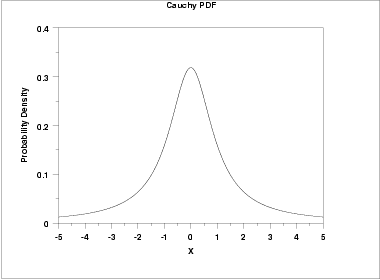 | ||||||||||||||||
| Cumulative Distribution Function | The formula for the cumulative distribution function for the Cauchy distribution is The following is the plot of the Cauchy cumulative distribution function. 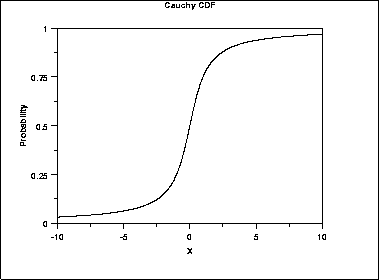 | ||||||||||||||||
| Percent Point Function | The formula for the percent point function of the Cauchy distribution is The following is the plot of the Cauchy percent point function. 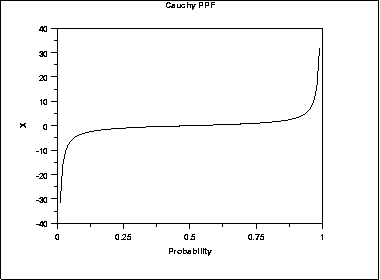 | ||||||||||||||||
| Hazard Function | The Cauchy hazard function can be computed from the Cauchy probability density and cumulative distribution functions.The following is the plot of the Cauchy hazard function.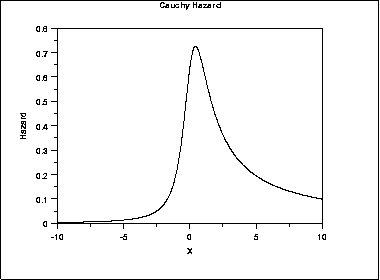 | ||||||||||||||||
| Cumulative Hazard Function | The Cauchy cumulative hazard function can be computed from the Cauchy cumulative distribution function.The following is the plot of the Cauchy cumulative hazard function.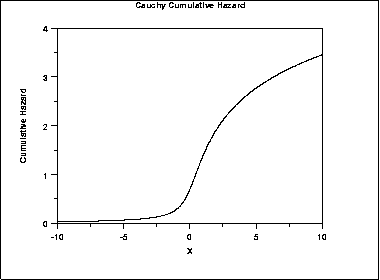 | ||||||||||||||||
| Survival Function | The Cauchy survival function can be computed from the Cauchy cumulative distribution function.The following is the plot of the Cauchy survival function.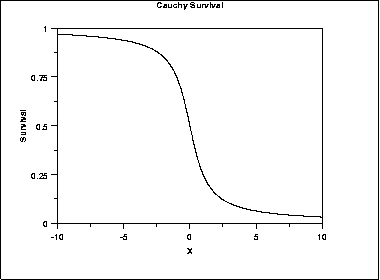 | ||||||||||||||||
| Inverse Survival Function | The Cauchy inverse survival function can be computed from the Cauchy percent point function.The following is the plot of the Cauchy inverse survival function.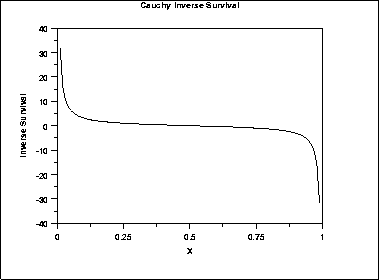 | ||||||||||||||||
| Common Statistics |
| ||||||||||||||||
| Parameter Estimation | The likelihood functions for the Cauchy maximum likelihood estimates are given in chapter 16 of Johnson, Kotz, and Balakrishnan. These equations typically must be solved numerically on a computer. | ||||||||||||||||
| Comments | The Cauchy distribution is important as an example of a pathological case. Cauchy distributions look similar to a normal distribution. However, they have much heavier tails. When studying hypothesis tests that assume normality, seeing how the tests perform on data from a Cauchy distribution is a good indicator of how sensitive the tests are to heavy-tail departures from normality. Likewise, it is a good check for robust techniques that are designed to work well under a wide variety of distributional assumptions.The mean and standard deviation of the Cauchy distribution are undefined. The practical meaning of this is that collecting 1,000 data points gives no more accurate an estimate of the mean and standard deviation than does a single point. | ||||||||||||||||
| Software | Many general purpose statistical software programs support at least some of the probability functions for the Cauchy distribution. | ||||||||||||||||
Runs Test for Detecting Non-randomness Purpose: Detect Non-Randomness The runs test ( Bradley, 1968 ) can be used to decide if a data set is from a random process. A run is defined as a series of increasing values or a series of decreasing values. The number of increasing, or decreasing, values is the length of the run. In a random data set, the probability that the ( I +1)th value is larger or smaller than the I th value follows a binomial distribution , which forms the basis of the runs test. Typical Analysis and Test Statistics The first step in the runs test is to count the number of runs in the data sequence. There are several ways to define runs in the literature, however, in all cases the formulation must produce a dichotomous sequence of values. For example, a series of 20 coin tosses might produce the f...
Comments
Post a Comment